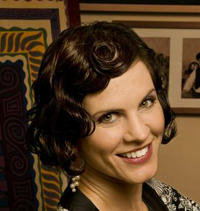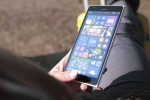
Regina Dugan, former director of the U.S. Defense Advanced Research Projects Agency, paced the stage, about to unveil a dizzying array of technologies developed by her new employer, Google’s Advanced Technology and Project group (ATAP). But first, attendees at the 2015 Google I/O conference needed a little background.
“We’ve been talking about wearables for two decades, maybe longer,” said Dugan. “Whenever I’ve seen a field where many smart people have worked for a long time and we’ve struggled for big breakthroughs, it’s been because there’s one underlying scientific principle that we’re missing, and if we can find it, it might unlock new strategies or opportunities.”
In asking this question about wearables, her team discovered 1954 research from Paul Fitts, a psychologist at the Ohio State University, entitled “The Information Capacity of the Human Motor System in Controlling the Amplitude of Movement.” The work, subsequently validated in 2012 by Google’s technical program lead Ivan Poupyrev, demonstrated the load on the human motor cortex system, measured in bits per second, required for doing increasingly precise finger-tapping activities on smaller and smaller areas.
Dugan continued: “Now there were controversies and nuances to it, but that science taught us something interesting about wearables… If we look at the limit that is imposed by the system that goes from the shoulder to the tip of my finger, which is the system that I used to control most consumer electronics, we see something interesting… As the screen size shrinks to the point where we can put it on our body, we are approaching the limit of our ability to interact with it.”
Google ATAP has been working on two ways to deal with the smartwatch conundrum of how to interact with a powerful computer via a tiny screen. One, Project Soli, uses a tiny radar system to detect complex finger gestures near—but not touching—the device’s screen. The other, Project Jacquard, provides a larger surface area via conductive fabric that can be woven into clothing and used to interface with devices.
These projects are still in early testing stages, and Google can afford long-term R&D successes and failures (such as the currently dormant, possibly defunct Google Glass, whose primary drawback was a lack of social acceptance by consumers). Of course, other wearable technologies have successfully been launched, such as smartwatches and fitness trackers.
The lifespan of a smart device startup, however, can be brutally short. Enter HAX, whose tagline is “The first mentorship-driven seed funding hardware accelerator program.”
‘Shark Tank’ meets Kickstarter
The popular television show “Shark Tank” gives entrepreneurs and inventors the chance to pitch products to a panel of venture capitalists in hopes of gaining an investment in exchange for equity. Many of the products seem forgettable, but the process has proven highly addictive to the viewing public.
Mainstream America is less aware, however, of a similar battle for investment being waged on the crowdfunding platform Kickstarter. Here, many smart devices and wearables get their first chance to fly, fail, or both. HAX (formerly known as HAXLR8R) provides a unique end-to-end service for aspiring inventors who need to develop smart products, manufacture them in China, and deliver them worldwide. They have successfully validated more than 65 products via Kickstarter—and seen them flourish beyond their multi-million-dollar launches.
Nest, Beats, Oculus, Kiva, MakerBot, Square, Jawbone, Magic Leap, Xiaomi and more are the new hardware giants. They are enjoying a perfect storm, according to the HAX annual report, “Hardware Trends 2015.” It reads: “Falling prices and advances in computing, sensors, batteries and connectivity have ushered a wave of ‘sentient’ objects. Those connected devices (smartwatches, trackers, sensors…) largely rely on the computing power of smartphones, or the cloud.”
“We try to help hardware startups avoid most of the mistakes that kill many of them,” said Benjamin Joffe, general partner for HAX based in Shenzhen, China. “Essentially the approach we call lean hardware is planning how to build the right thing and build things right,” he said in an October 2014 talk at the Hardware Startup lab meetup in London.
HAX mentors entrepreneurs, providing them an understanding of manufacturing, cash flow, fast launches and sustainable business. “Shenzhen is definitely the access to the world’s best supply chain,” said Joffe, who advises startups to avoid wasting too much time trying to fix shoddy 3D printer output for early prototypes. And expertise in manufacturing is no small thing, he added.
If it works for Apple…
Before Apple famously chose the Foxconn factory in Shenzhen to make its devices, there was Silicon Valley, where both Steve Jobs and the culture of software innovation were born. The logic that software provides turns out to be a critical component for IoT success.
“Pure hardware is hard to protect: Take it apart and it can often be reverse-engineered,” wrote Joffe and HAX founder Cyril Ebersweiler in the TechCrunch article “8 Things About Hardware Crowdfunding We Learned From 20 Campaigns.”
“These days, beyond designs and patents, there is ‘defensible IP’ in software, algorithms, or a community that a crowdfunding campaign can help you build.”
Ironically, as the Shenzhen supply chain flourishes and the Apple success stories loom in the imaginations of wearables entrepreneurs, there’s a certain assembly-line mentality afflicting design teams, according to Dirk Knemeyer, founder of Involution Studios in Boston. In “Designing for Emerging Technologies: UX for Genomics, Robotics, and the Internet of Things,” he admonishes design teams that forget the true lessons of Apple.
“Jobs excelled at not just looking across various technologies and identifying sweet spots, but tying those into the needs and desires of people,” he said. “Jonathan Ive, a trained industrial designer, is more deeply knowledgeable in the materials science and engineering relative to actually having those products get made. The getting it done, the fit-and-finish, the vision-to-reality… These are the contributions of Ive. Together, Jobs and Ive made Apple the preeminent business case of the 2000s. And they did it by inventing, innovating and making better stuff.”
In the future, wearables and emerging technologies will require skills and partnerships that are far more diverse than what Jobs and Ive brought to the table, according to Knemeyer. But it also will require vision. “Whereas great design in the past was typically credited to a single vision—what is now often derisively referred to as ‘genius design’—we are in the midst of a decade-long trend toward highly specialized design teams that might or might not have strong, visionary leadership,” he said.
“These are your typical ‘UX teams,’ those that banded together within the cult of ‘human-centered design’ and now continue to practice similar approaches while changing their self-description to better conform to the dogma of the day. This shift superficially seems to be the result of the increased complexity that software forces design to deal with. This is an easy myth to ascribe to, and one that is further comforting thanks to the so-called scientific approaches offered by metrics-based processes such as usability testing.
“However, in reality this shift is an issue of scale: There are so few strong, talented creative leaders that to get decent software done, larger teams of narrow talent were required.”
Both Ebersweiler and Knemeyer agree, then, on the critical role of creative software in wearable hardware. But there’s a third, equally elusive ingredient to wearable success: community.
Why the Pebble persists
It’s anyone’s bet whether the Pebble smartwatch, one of Kickstarter’s first crowdfunding device success stories (US$10 million raised in 2012), will survive long after the launch of the Apple Watch. But the e-paper-based watch has done well so far thanks to a thriving community of developers who create apps that link the wrist watch to an accompanying smartphone—just like Android and iOS watches link to their respective mobile mother ships.
Why did Pebble’s community arise? A partnership with the popular RunKeeper app helped amid early criticism of the lack of app-based functionality. Other simple use cases followed: creative watch faces, a haptic metronome, apps that surface notifications (weather, text, sports scores, etc.) from Android phones, bus schedules, remotes, two-factor security, Foursquare, Yelp, GPS and more. So you wouldn’t want to use the monochromatic, non-retina display to shop on Amazon. (Do you really want to shop on your watch anyway?)
The bigger question, then, isn’t which smartwatch will succeed—since there are now more consumer choices for these still-evolving smart watches—but which will inspire the community. An early failure to collaborate doomed Nike FuelBand to struggle amid a lack of offerings for its closed platform. Apple Watch will have a serious advantage with its massive, high-quality app store, though it again remains to be seen how many iOS developers will port ever-smaller, “glanceable” app offerings to the smartwatch.
HAX alludes to one way to build community: crowdfunding, and the media hype that precedes and follows a successful campaign. But there are others. Product Ninja, for example, calls itself “A hub for physical product-loving enthusiasts to discover, share and discuss the latest hardware tech projects.” The idea is to pre-test product ideas and grow early communities around them. There’s plenty of overlap with Kickstarter projects such as Prynt (a phone-sized photograph printer) and Flixi for framing and hanging photos without nails, using 3M command tape and built-in bubble levels. Interestingly, Flixi has not neglected the cloud/app angle: The product comes with a Web app for helping design a photo wall.
These are purely consumer products, and the wall-designing app won’t win a Nobel Prize for its brilliance. But what about geekier, software-based ecosystems? While the open-source world offers plenty of lessons, too often tech startups get this horribly wrong. As Joel Spolsky blogged, “There are an awful lot of technology companies, founded by programmers who think they are building communities on the Internet, but they’re really just building software and wondering why the community doesn’t magically show up.”
Richard Millington, founder of online community guide FeverBee and author of “Buzzing Communities: How to Build Bigger, Better and More Active Online Communities,” said failed community efforts often start backward.
“The opportunity is to build a community around a strong common interest/purpose (e.g. seamless photo sharing) and then develop the dream product for that community,” he wrote on his blog. “When you launch the product, you will already have a dedicated community of people eager to use it. These people are more likely to promote it to others. Seth Godin defined this best: Find products for your audience, not audiences for your products.”
Success in creating a fertile ecosystem is one reason Under Armour athletic wear bought app and hardware maker MapMyFitness in 2013. MapMyFitness connects hundreds of hardware devices and collects vast amounts of exercise data that its parent company can now use.
And ecosystems aren’t limited to software: Freescale Semiconductor offers not only a chip, but also product design expertise. The company’s WaRP is an open-source platform for developers interested in rapid prototyping. It contains a main processor and add-on daughtercard for sensor aggregation and wireless charging, as well as an LCD or low-power e-ink display with touchscreen. Sensors include accelerometer, magnetometer and pedometer. Power management is critical for wearables, so this platform can go into deep sleep mode while still monitoring sensor data. The company also says that you don’t have to go it alone: It offers an ecosystem with assistance from Revolution Robotics and Kynetics for experienced product design.
Keep it simple
The experts agree: The best devices take advantage of form factors and capabilities rather than struggle against their limitations. An example is micro-gaming, the smartwatch-based form of gaming that follows in the footsteps of finger-gaming, which itself took the gaming world by surprise with the breakout success of Angry Birds on the iPhone.
From 3 Minute Games, Lifeline is a game that takes place entirely via push notifications. The time-delayed story unfolds in choose-your-own-adventure fashion, with players able to respond to texts that simulate a stranded astronaut, Taylor, who needs their help to escape death in outer space. Prototyped in Twine, an open-source tool for writing interactive fiction, the game was also enabled by iOS 8’s ability to let users interact with notifications on the lock screen.
The storytelling and delivery mechanism are perfect for each other, but the concept harkens back to Tamagotchi, the Japanese digital handheld pet launched in 1996 and still going strong (75 million sold to date) nearly 20 years later. Like Tamagotchi, much of the gameplay happens in the user’s head as he or she develops an attachment to the fictional astronaut or pet, then strives to respond appropriately to notifications and keep it alive as long as possible. This is pure entertainment, unlike the quantified self that’s made possible by fitness trackers.
While fitness bands have their detractors, the exercise market has by no means flat-lined. Google Fit’s open platform for writing fitness apps has a Recording API to estimate steps taken, weight lifted or calories burned, a History API to send data to the app, and a REST API to access data over the Web. The latest version of Android Wear lets developers pair heart rate straps or bicycle cadence sensors to their Wear device, sans phone. It’s likely that fitness will migrate away from standalone bands to other types of wearables, including clothing or sensors placed on limbs or feet, not precious wrists.
No bad ideas, only untested ones
Ultimately, wearables will reward those who test this burgeoning market early and often. Devices and tools abound, from data analysis for IoT and app deployment, to fleets of devices, IoT device management, and prototyping platforms and services.
Commoditization may be rampant among activity trackers, smartwatches, 3D printers and drones, but there are plenty of new opportunities, according to the HAX report. “The way out might be in new sensor technologies (non-invasive or embedded), design, software, AI and communities of users or developers,” it said. “New applications in sports, preventive and personal health are creating emerging behaviors toward human augmentation.”
You might not want to wear it forever, but Lumo Lift, the posture tracker that pings you when you slouch? That just might be brilliant.
The tedium of the quantified self
Deck: Misfit Wearables engineer on designing wearable devices: Use magic
At the inaugural Wearables DevCon in Burlingame, Calif., Rachel Kalmar, an engineer with Misfit Wearables, suggested that the future of wearables must go beyond pedometry. She wore several dozen devices on her wrists, belts and even boots, including a Victorian mechanical pedometer and a handful of her company’s Shine devices. But they all had one purpose: Detecting physical activity.
A graduate of Stanford’s design lab, Kalmar had the room break into small teams and begin designing the future of wearables using brainstorming techniques. Magic was not offlimits, she said.
Well, when given permission to use magic, I went for it. Here are the two devices I designed: An Art Focus ring (modeled after the giant square ring I was wearing), and a waist cincher/inch-counter for weight loss.
My partners were both interesting in their own right: Kevin Shaw, CTO of Sensor Platforms, has more than 20 years’ experience in sensors and MEMS, and was an engineer at Kionix, a leader in motion sensors and accelerometers, integral in establishing its MEMS process and design. My other partner, Sireesha Chilakamarri, is a Southern California-based senior software engineer at Barracuda Networks who has designed an Android app for signature receipt.
“When you can’t come up with an idea for your device, sometimes it’s good to come up with bad ideas,” Kalmar suggested. My best bad idea for a device form factor was a dental helmet. I also came up with a cane, which Shaw said was actually a good idea for sensors. He was wearing a discreet Shine device on his right wrist, which he said he liked because “It’s a ‘don’t-care,’ and the battery lasts six months.” However, he showed that telling time on the device was slow and non-intuitive, so he tended to look at the regular analog watch on his left wrist. When pressed, he admitted to checking the Shine activity data on the accompanying app a few times a week, but that it was mainly for entertainment.
Hardware + Software + Community = Success
Your smart device won’t be long for this world without an accompanying app strategy, according to the annual report on hardware trends by hardware incubator and accelerator HAX. Because pure hardware can be reverse-engineered, it usually will be. Plenty of Kickstarter gadget successes—Pressy, Olloclip and Tile—soon found their margins eliminated by fast-moving copycats.
Thus, a successful hardware launch must not only do something difficult, it must be part of a larger ecosystem: software and community. According to the report, “Almost all HAX startups use an app/cloud.” Algorithms are “hard to replicate,” and a community of developers, makers and enthusiasts, such as those around GoPro, MakerBot, Pebble and Google Glass, injects life and passion into the project.
Further, the HAX report warns hardware entrepreneurs of 12 types of “wares” that portend failure:
- Nicheware (including artware and funware) has too small a market.
- Easyware is too easy to copy (see Tile, Pressy, Olloclip).
- Sameware is too similar to something else.
- Solutionware (which doesn’t solve any known problem) is common among academic teams.
- Vaporware cannot be made, and is possibly even a scam (such as the HUVr Board prank).
- Lameware doesn’t work.
- Failware is totally wrong.
- Lateware is so delayed that by the time it’s ready, competitors have already conquered the market.
- Lossware has no profit margin.
- Boreware is — like most wearables today — a device that consumers tire of and eventually abandon.
- Futureware is ahead of its time—too innovative for today’s market.
- Localware suffers from the “Galapagos Effect,” such as Japan’s flip feature phones and China’s smartphone/shaver.






